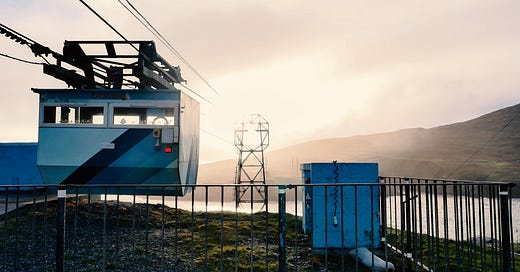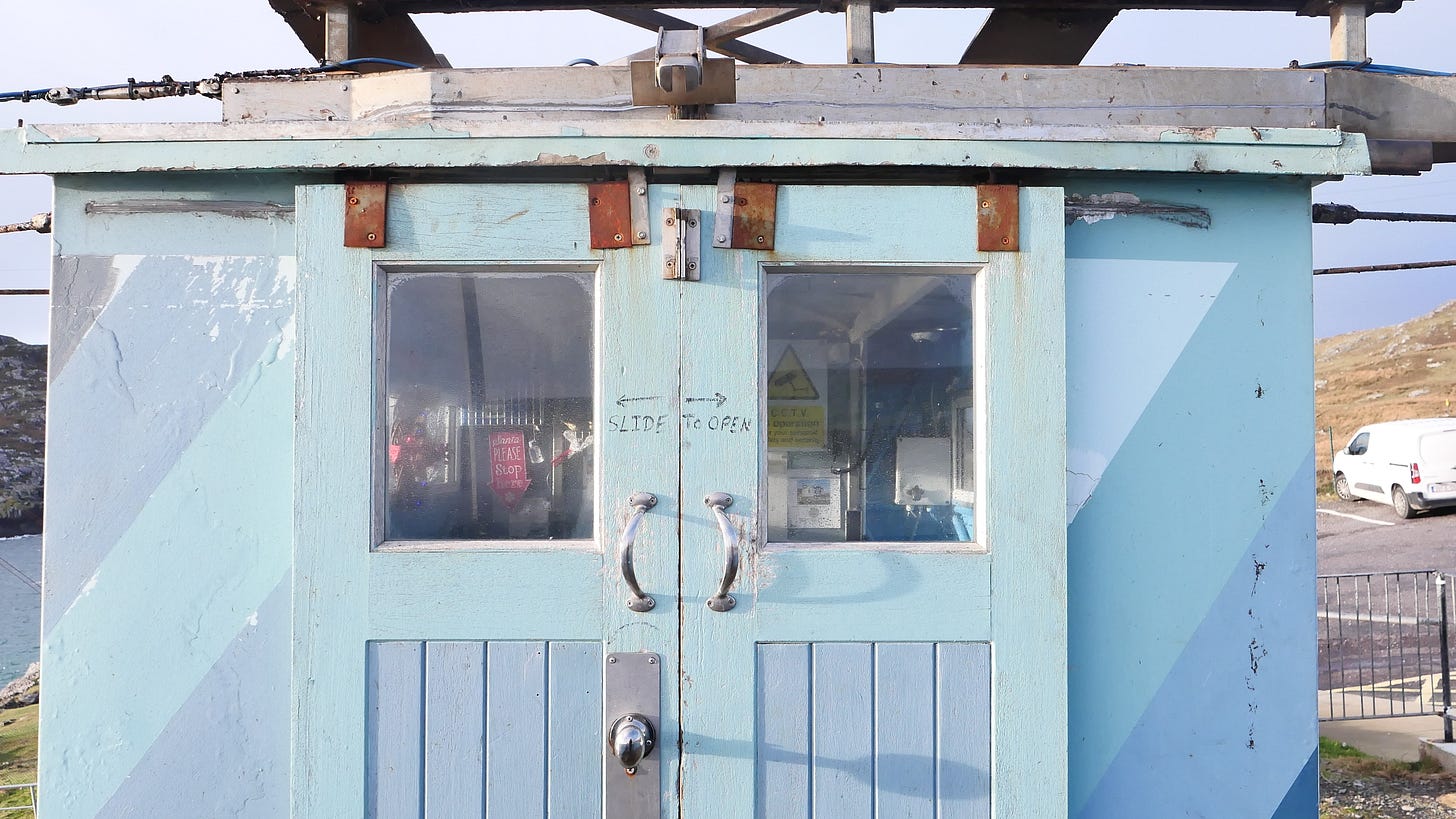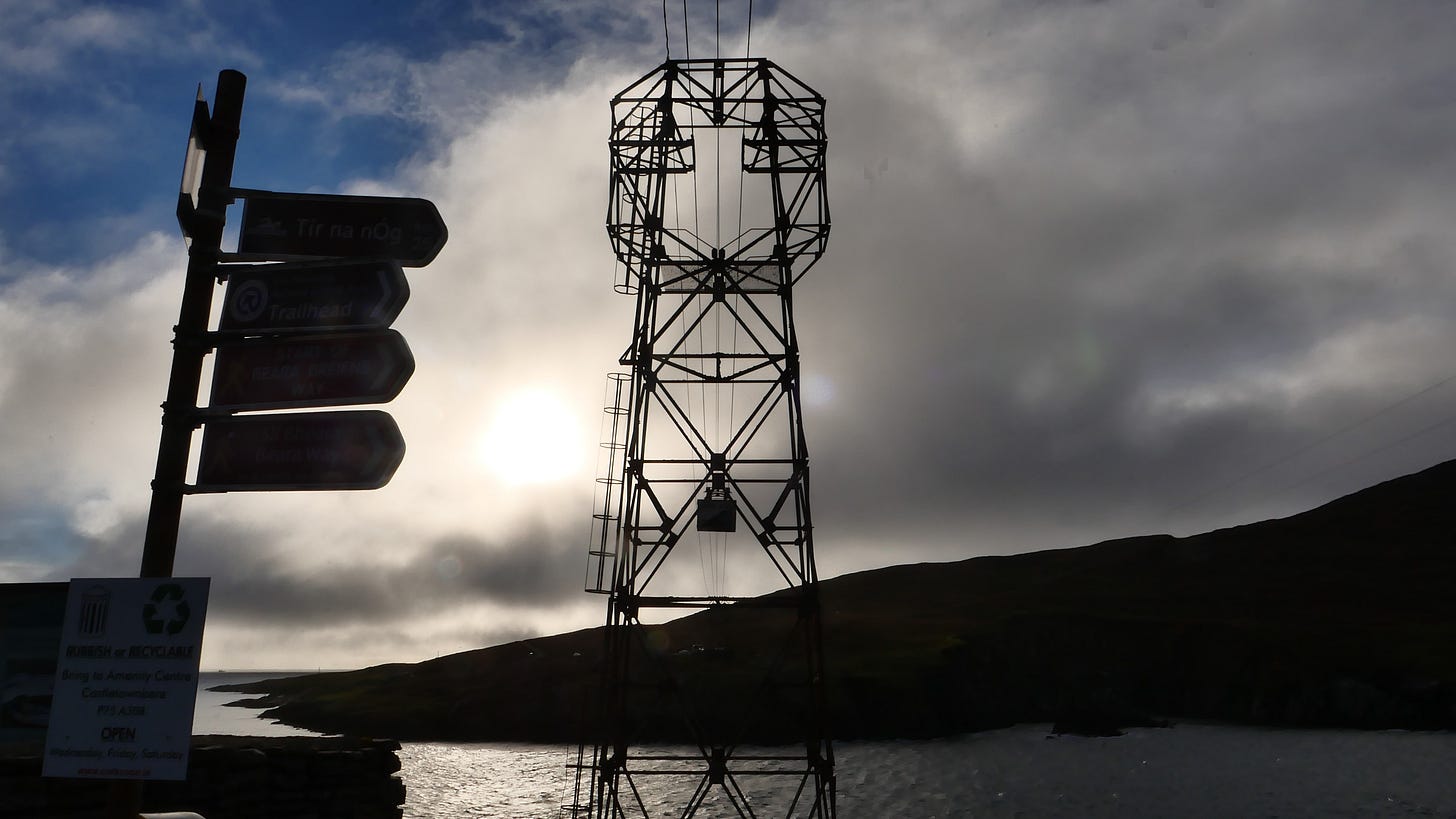A visit to Dursey cable car
On the Beara Peninsula, Ireland's only cable car is set for a big upgrade over 50 years after its construction, with most locals glad of the extra tourism business.
Dursey Island’s famously rickety old cable car will soon be no more.
An Bórd Pleanála has given the go-ahead to upgrade the Dursey cable car, the only cable car in the country, and to develop a visitor centre at its site on the remote Beara Peninsula in West Cork.
The upgrade will see an improved system with a cable car going in either direction. Each car will facilitate 15 people, a significant upgrade from the six passengers the current car can handle.
A visitor centre similar to the one at Mizen Head Signal Station, across the peninsula from Dursey, will be built at its current departure point on the mainland, with a smaller hub at the arrival port on the island.
Hopping across to Dursey Island on the shaky cable car is an attraction in and of itself; the height of summer season can see three-hour queues at either end. The cable car has had upgrades in 1981 and 2004, but for many, its shakiness gives it a fairground ride, mildly adrenaline-inducing appeal.
While the island attracts those who travel the long road to Dursey to take a cable car across the narrow but treacherous stretch of water known as Dursey Sound for the rugged views, wildlife photography or world-class walking trails, a good deal of visitors simply want to experience the mild thrill of a journey over water on Ireland's only cable car.
The upgrade is expected to cater for both markets, while reducing wait times dramatically.
News of the development is widely welcomed among local communities, with residents of the island and from surrounding mainland parishes generally in favour of the upgrade.
But to minimise disruption to the natural surroundings, planning was granted with a caveat that visitor numbers to the island be capped at 5,000 per month, amidst concerns from some environmental groups that a flood of visitors might damage Dursey’s pristine ecosystem and wildlife habitat.
A history of slowly declining population
The history of Dursey Island is not dissimilar to that of the Aran Islands or indeed the Blaskets in Kerry: like everywhere else in Ireland, Dursey island's population bore the brunt of emigration.
There wasn’t a sudden exodus of people from Dursey Island like there was on the Great Blasket due to emigration and the impossible plight the islanders endured in its last days as a community.
On Dursey, family members who didn’t emigrate or move to a more populated part of Ireland stayed on the island, meaning the demise of the population was more of a slow, grinding halt.
In fact, there are still two full time residents on the island: natives. One of them is a man in his eighties who returned from the UK about 15 years ago.
Dursey’s history runs deep in the psyche of the locals, many of whom have familial or even first-hand connections to the island. The preservation of its history through an interpretive centre would likely bring more recognition and a deeper relevance to Dursey’s history and to the wider Beara Peninsula in general.
On a wet and windy day November day, I’m at the Dursey Island Cable Station. Out of the cable car on the first crossing from the island is Rosarie O’Neill and her husband Batty.
Rosarie was born on Dursey and went to primary school there. She recalls being one of 17 pupils at the time. When the day came to go to secondary school, staying in Castletownbere was the nearest and best option available. She built a house on the island 19 years ago; the first to be built there for 70 years. She and her husband go between there and their home on the mainland regularly, winter and summer.
An idyllic living arrangement, you might say. One that, on the face of it, stands to be disrupted by the new development and extra traffic to and from the island. Rosarie disagrees.
“The more the merrier,” she says. “We’re all very happy with the development. It’s progress, and it’s jobs for the area. We all stand to benefit from this development.”
The island only has two full-time residents, but there are 15 houses in regular use on the island including Rosarie’s.
“We need jobs here,” her husband Batty says. “Below in Mizen there’s a good ten jobs in the visitor centre. We need ten jobs here.”
But the upgrade hasn’t been without its objectors.
“Mass Tourism” and the law of economics
Tony Lowes is one of the directors of Friends of the Irish Environment (FIE), whose office is on the Beara Peninsula; he describes the group as “a kind of splinter group from An Taisce and the National Trust.”
FIE formed in the nineties when Michael D Higgins, then Minister for Heritage, brought in a new habitats directive based on EU law; FIE founders had little confidence in local authorities' ability to implement the directive. Since then, the group has become known to challenge an array of many planning decisions and what they call “bad decisions.”
FIE are against what they say will be “mass tourism” in the area; Dursey Island is an important habitat for bird life in particular, and home to but they are not totally opposed to developments at Dursey.
“It’s the type of tourism that’s at stake here,” Tony says, in a roadside coffee shop in the village of Eyeries, 30km up the rugged Beara peninsula from Dursey.
“We want those tourists in our Bed and Breakfasts, we want them in our cafés, we want them in our AirBnBs. We don’t want to watch them go by in big buses. And that’s what mass tourism is, and that’s what it does to rural places.”
5,000 visitors using the cable car each month could hardly be considered “mass tourism,” surely?
“Actually, the capacity of the cable car system that they are putting in is 6,600 a day,” Tony says. “But they say they’re going to cap it at 5,000 a month. This simply doesn’t make sense to us. It just means, in the end, they will get to that capacity, because that’s what they want to do.”
“We want a new cable car for Dursey; don’t get us wrong. We want signage at the main road and we want basic facilities out there. But we do not need or want a cable car system to bring 6,600 people out there every day, because that’s what you’re going to end up with. That’s the law of economics.”
One small step for Donal Kelly, one giant leap for Dursey
Donal Kelly not only actually helped to build the original cable car, but he was the first person to ever make the crossing to the island in it.
Now the managing director of fish import and shipping company Fast Fish Limited in Castletownbere, Donal was born a few houses away from the site of the cable car. At just 17, he worked as a labourer on the building of its original inception between 1967 and 1969.
He was also tasked with the mission of being the first person to test out the cable car: he was the very first person to cross Dursey Sound on Ireland's only cable car. Not that he makes any bones about it. “The boss just asked me if I’d try it out, so I said I would, and that was that,” he says.
So as someone with such a strong connection to the cable car, how does he feel about An Bórd Pleanála’s decision to go ahead with the upgrade and visitor centre? He has, it seems, mixed feelings; the economic benefits are an important draw.
“They did a fine job over at Mizen,” he begins, referring to the Mizen Head Signal Station that opened in 1994. “We have three sources of income on the Beara Peninsula. Fishing, Farming and Tourism. And there’s expansion in only one, and that’s tourism,” he says.
A frightened priest and a cable car for cows
One of the main concerns for those opposed to the development is that the roads around the area will not sustain the influx of traffic. But Donal believes traffic won’t be a problem.
“I don’t think it will increase the traffic that much,” he says. “The only place the traffic will be increased is on the island, with footfall and walkers. I would hate to see Dursey Island overrun with tourists. But still, it's a big asset, and an asset is only as good as how well you develop it. That's the bottom line with it.”
The original idea for the cable car came from a local priest by the name of Fr Keane, who had had “a terrifying experience” on a rough crossing to the island to perform last rites on an islander in the mid-sixties, Donal tells me.
“After that, he then spearheaded the campaign for a cable car,” Donal says. “He could see the distance from the mainland to the island and thought a cable car would work.”
The idea was initially met with skepticism, but even so, the cable car was built. Donal believes the introduction of the cable car extended the life of the island's population by about 40 years. For the islanders, bringing their yawl boats ashore was a dangerous and laborious task that required many hands.
As a child in the mid-fifties, Donal recalls periods of up to three weeks at a time when residents of the island would have to stay at his house when the weather would be too severe for them to make the crossing home.
“They were fantastic people,” he says. “Big families. All island people are survivors, and my God, could they survive. The salt of the earth. I’ve absolutely no doubt that the cable car extended life on the island. It was getting too hard there.”
Up until then, it was common practice that cows would have to swim next to a boat when being brought to the mainland. From 1969, cattle were ferried across in the cable car one at a time, but for health and safety reasons, a stop was put to this practice in 2011.
Fr Keane had pushed the council to fund the innovative project, and construction began in 1967.
“The council put in the footings of the eight legs, four on the mainland and four across on the island,” Donal says. “Then a British company came over and they erected it. We went working for them, and that was absolutely brilliant because we were getting the same wages at home as some of the people who emigrated to England were getting.”
An “amazing feat of engineering”
“It was an amazing feat of engineering at the time,” Donal says. “Not too long before that, people had to leave the Blaskets, and they were heart broken. That didn’t happen here, and that was thanks to the cable car."
John Terry runs a grocery shop and fuel pumps in the middle of Allihies village, 12km from the cable car and, with its dramatic mountainous backdrop and abandoned copper mines, something of a tourist attraction itself.
Alongside the shop, John and his wife run a guest house and says tourism is the only thing keeping the Beara Peninsula going. What has the cable car done so far for the area?
“Look, sure it's an extra attraction in the area,” he says. “There’s a lot of passing trade going back to it, people staying weekends, coming down and walking on the island. In general, it’s a big plus to the area.”
John’s mother-in-law was born on Dursey and he and his wife regularly return to go walking.
“Last Thursday was my wife’s birthday so we went to the island and walked it,” he says. “We went from the cable car and right around. It’s definitely one of my favourite walks.”
How does John feel about the proposed developments at Dursey?
“I've been in business for 47 years. We are now dependent on tourism to keep us going. Simple as that. We have a guesthouse, and if we didn’t have the guesthouse we wouldn’t be surviving.”
“There’s no young blood starting off in the tourist industry. In the bed and breakfast industry, it’s all elderly people in their 60s, right through the peninsula. There might be the odd one or two in their 30s or 40s but it needs a bit of impetus, more life back into it. I’d be hoping that this would bring the extra traffic,” he says.
As is, the cable car continues to be an institution of Cork history and Irish tourism: it’s a “must do” stop along the Wild Atlantic Way, perhaps one of those things that must be seen to be believed.
Hunger for development on the Beara Peninsula seems for the most part to outweigh concerns about what a five-fold increase in visitors to Dursey Island will mean for the area.
Even the project's opponents would like to see development there, albeit scaled back. While farming and fishing communities fear for their future as sustainable industries, tourism in Ireland seems like a safe bet.
Even today, amid successive waves of Covid-19 related travel restrictions, domestic tourism goes a long way towards fending off bleak summers in tourist hot spots around Ireland. For Beara, the Dursey cable car is a big cog in the wheel of domestic tourism. Whether increasing the size of that cog will bring only positives remains to be seen.











